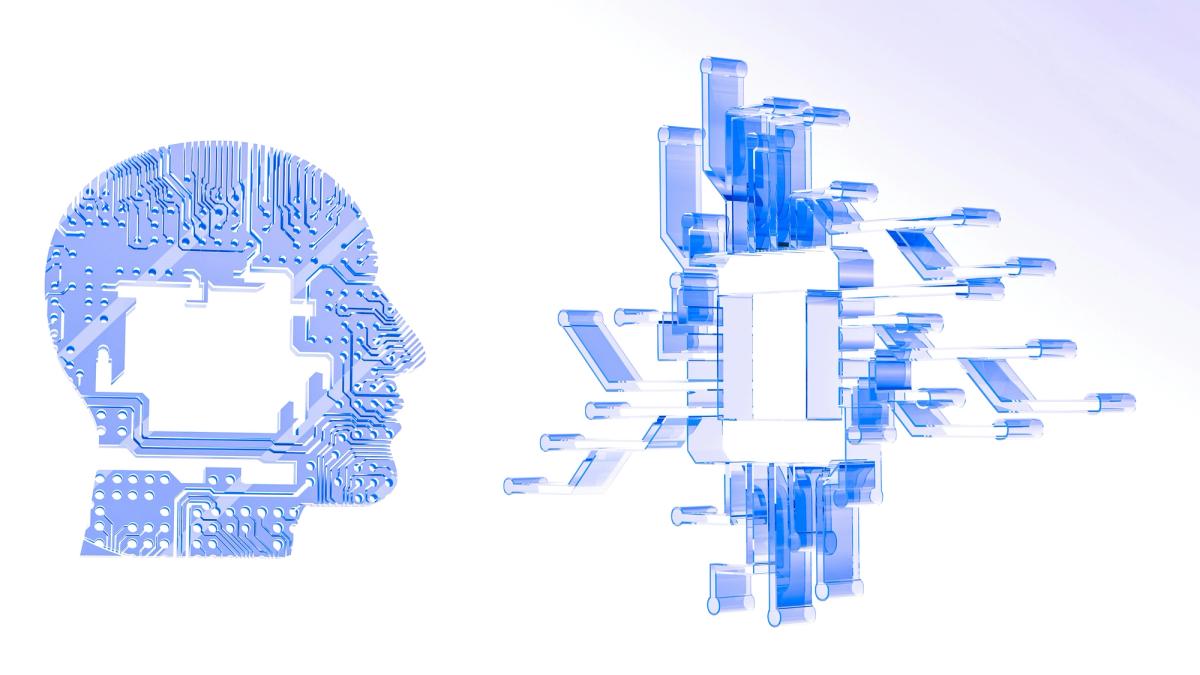Complete AI Inference vs. Training Guide for Smarter Models
Published on May 9, 2025
Get Started
Fast, scalable, pay-per-token APIs for the top frontier models like DeepSeek V3 and Llama 3.3. Fully OpenAI-compatible. Set up in minutes. Scale forever.
Building AI models can feel like a fun rollercoaster ride. But what happens when the ride suddenly stops? You’ll want to get off at the next exit and discover what’s causing the delay—hopefully before the other passengers get antsy. When training and inference have trouble communicating, it can derail your model's performance and user experience. This article will help you smooth out the ride with insights on AI inference vs. training to boost the efficiency and cost-effectiveness of building and deploying your AI models. You'll learn how to use machine learning optimization for performance and scalability to get your project back on track and deliver on your goals.
One solution to address the challenges of AI inference vs. training is AI inference APIs. These powerful tools help you achieve your objectives by building and deploying AI models more efficiently and cost-effectively.
What is AI Inference and Training?

As we all continue to refine our thinking around artificial intelligence (AI), it’s helpful to define terminology that describes the various stages of building and using AI algorithm—namely, the AI training stage and the AI inference stage. As we see in the quote above, these are not new concepts; they’re based on ideas and methodologies that have existed since before Sherlock Holmes’ time.
If you’re using AI, building AI, or just curious about AI, it’s essential to understand the difference between these two stages so you know how data moves through an AI workflow. That’s what I’ll explain today.
The TL: DR
The difference between these two terms can be summed up fairly simply: first, you train an AI algorithm, then your algorithm uses that training to make inferences from data. To create a whimsical analogy, when an algorithm is training, you can think of it like Watson, still learning to observe and draw conclusions through inference. Once trained, it’s an inferring machine, a.k.a. Sherlock Holmes.
Whimsy aside, let’s explore the tech behind AI training and AI inference, the differences between them, and why the distinction is essential.
Obligatory Neural Network Recap
Neural networks have emerged as the brainpower behind AI, and a basic understanding of how they work is foundational to understanding AI. Complex decisions can be broken down into yeses and nos, meaning they can be encoded in binary.
Neural networks can combine enough of those smaller decisions, weigh how they affect each other, and then use that information to solve complex problems. Because more complex decisions require more information points to reach a final decision, they need more processing power. Neural networks are one of the most widely used approaches to AI and machine learning (ML).
What is AI Training?: Understanding Hyperparameters and Parameters
In simple terms, training an AI algorithm is the process through which you take a base algorithm and then teach it how to make the correct decision. This process requires large amounts of data and can include various degrees of human oversight. How much data you need relates to the number of parameters you set for your algorithm and the complexity of the problem.
The Complexity of AI Training
And hey, we’re leaving out a lot of nuance in that conversation because dataset size, parameter choice, etc., is a graduate-level topic. Companies training an AI algorithm usually consider it proprietary information.
The Interplay of Data and Parameters
It suffices to say that dataset size and number of parameters are significant and related to each other, though it’s not a direct cause-and-effect relationship. Both the number of parameters and the size of the dataset affect things like processing resources, but that conversation is outside the scope of this article (and is a hot topic in research).
Use Case Dictates AI Architecture
As with everything, your use case determines your execution. Some tasks see excellent results with smaller datasets and more parameters, whereas others require more data and fewer parameters. Bringing it back to the real world, here’s a very cool graph showing how many parameters different AI systems have.
Note that they very helpfully identified what type of task each system is designed to solve. So, let’s talk about what parameters are with an example. Back in our very first AI 101 post, we talked about ways to frame an algorithm in simple terms:
Instructional Flexibility in Machine Learning
Machine learning does not specify how much knowledge the bot you’re training starts with; any task can have more or fewer instructions. You could ask your friend to order dinner, or you could ask your friend to order you pasta from your favorite Italian place to be delivered at 7:30 p.m. Both of those tasks you just asked your friend to complete are algorithms.
The first algorithm requires your friend to make more decisions to execute the task at hand to your satisfaction, and they’ll do that by relying on their experience of ordering dinner with you, remembering your preferences about restaurants, dishes, cost, and so on.
Framing Learning with External Settings
The factors that help your friend decide on dinner are called hyperparameters and parameters. Hyperparameters frame the algorithm—they are set outside the training process, but can influence the algorithm's training. In the example above, a hyperparameter would structure your dinner feedback.
Do you give each dish a thumbs-up or thumbs-down? Do you write a short review? You get the idea. Parameters are factors that the algorithm derives through training. In the example above, that’s when you prefer to eat dinner, which restaurants you enjoy after eating, and so on.
Weighting Significance in Neural Networks
When you’ve trained a neural network, there will be heavier weights between various nodes. That’s a shorthand for saying that an algorithm will prefer a path it knows is significant. If you want to get nerdy with it, this article is well-researched, has a ton of math explainers for various training methods, and includes some fantastic visuals.
From Training to Confident Predictions
The “dropout method” essentially adds weight to the relationships an AI algorithm has found significant for the dataset it’s working on. The algorithm can then de-prioritize (or sometimes even eliminate) the other relationships. Once you have a trained algorithm, you can use it with a reasonable degree of certainty that it will give you good results, which leads us to inference.
What is AI Inference?
Once you’ve trained your algorithm, you can send it to the world to do its job (and make yours easier). When you present a trained AI algorithm with a problem and it gives you an answer, that’s called inference. It’s using the way it was taught to draw conclusions or make predictions, depending on how it was built, and once an algorithm is in the “inference stage”, it’s no longer learning (usually).
Real-World Inference: Not Always Perfect
As we’ve seen in the real world, this does not mean that the AI model will give you a perfect answer every time depending on, for example, the AI’s access to new or current information, the complexity of training, etc., the algorithm might give you a better or worse (more or less accurate) answer. Nevertheless, it can look at a new piece of information or a dataset and return a response.
When I asked our friend ChatGPT about this, it broke down inference and defined it in terms of the logical underpinnings of different algorithms. (As a human, how could I resist using inference while writing about inference?)
ChatGPT on Inference: A Self-Referential Example
Sure, ChatGPT may be merely mimicking human-like dialogue based on its ingestion of the whole internet, then giving me the most likely answer based on its specialized neural network that predicts the likelihood of the next word in response to my conversational query and without access to data after January 2022, but here’s what our AI friend had to say for itself:
Machine Learning Inference
In machine learning, after a model has been trained on a dataset, it is deployed to make predictions or classifications on new, unseen data. During inference, the model takes the input data, processes it, and produces an output or a prediction based on the patterns and relationships it learned during training.
For example, a trained machine learning model might be used to:
- Classify images
- Predict stock prices
- Identify spam emails
Deep Learning Inference
Deep learning, a subfield of machine learning, involves neural networks with multiple layers. In deep learning, inference means feeding an input through a trained deep neural network and obtaining an output. This is commonly used in applications like:
- Image recognition
- Natural language processing
- Speech recognition
Inference in deep learning can be computationally intensive, and specialized hardware, such as GPUs and TPUs, is often used to accelerate the process.
Rule-Based Systems Inference
In rule-based AI systems, inference is the application of logical rules to make decisions or draw conclusions. These systems use a set of predefined rules and facts to reason and infer new information. For example, in an expert system for medical diagnosis, inference involves applying rules to patient symptoms and medical knowledge to arrive at a diagnosis.
Probabilistic Inference
In probabilistic AI, inference is used to estimate probabilities and uncertainty. Bayesian networks and Markov decision processes are examples of probabilistic models that perform inference to compute probabilities of events or make decisions based on probabilities. You’ll notice that each of these basically says the same thing: the AI algorithm applies its decision-making paradigm to a problem.
Why Stop Learning During the Inference Stage?
In general, it’s essential to keep these two stages—training and inference—of an AI algorithm separate for a few reasons:
Efficiency
Training is computationally intensive, whereas inference is usually faster and less resource-intensive. Separating them allows for efficient use of computational resources.
Generalization
The model’s ability to generalize from training data to unseen data is a key feature. To maintain this ability, it should not learn from every new piece of data it encounters during inference.
Reproducibility
When using trained models in production or applications, it’s essential to have consistency and reproducibility in the results. If models were allowed to learn during inference, it would introduce variability and unpredictability in their behavior.
Some specialized AI algorithms want to continue learning during the inference stage—your Netflix algorithm is a good example, as are self-driving cars, or dynamic pricing models used to set airfare pricing.
On the other hand, most problems we’re trying to solve with AI algorithms deliver better decisions by separating these two phases—think of image recognition, language translation, or medical diagnosis, for example.
Related Reading
AI Inference vs. Training Guide

AI Training is focused on learning from data and optimizing the model. It requires a large, labeled dataset and significant computational resources, often relying on specialized hardware like GPUs or TPUs. The process is time-consuming, sometimes taking hours to weeks. During training, the model is continuously updated based on feedback from the data.
AI Inference, on the other hand, is about making predictions or decisions using the trained model. It operates on new, unseen data and typically requires less computation. Inference can often run on edge devices using standard CPUs, though GPUs may still be used for faster processing. The model parameters are fixed during inference unless retraining occurs. Inference is designed for quick responses, often in real time.
The primary distinction is that AI training is about teaching the model, while AI inference is about applying what the model has learned to make decisions.
Purpose: Understand How Training and Inference Differ
Training and inference are distinct processes, and it helps to know how they differ. Training, also known as learning or modeling, teaches a machine learning model to complete a specific task. This involves using historical data to help the model detect patterns. Training can take a long time to complete, depending on the size of the dataset and model complexity. Inference is the process of using a trained model to predict new data. It occurs in real time (or near real time) and is often critical to helping a machine learning application make decisions quickly and efficiently.
Data Flow: Explore the Different Types of Data Used
Training and inference also differ in the types of data they use. Training typically uses massive amounts of labeled data to help a machine learning model learn. The goal is to help the model generalize its understanding to predict new data accurately. The process often involves multiple passes through the dataset (epochs) to optimize the model’s performance. Inference, on the other hand, uses new, unlabeled data to generate outputs. The model has already been learned from historical data. Now, it applies its knowledge to predict incoming information during inference. This process occurs one sample at a time (or in small batches) so the application can provide timely results.
Computation: Different Processes Involve Varying Complexity Levels
Training and inference also differ in their computational needs. Training is computationally heavy. Neural network training involves iterative optimization techniques like backpropagation. In contrast, inference is often lighter in computation because it’s a forward pass through the network without the backpropagation step. Still, it can be significant depending on the complexity of the model.
Time Sensitivity: Timing Is Everything
Training and inference couldn’t be more different when it comes to time. Training can be done offline. Depending on the dataset size and hardware, it might take hours, days, or weeks. Inference usually happens in real time or near real time, requiring lower latency.
Hardware Requirements: What Do You Need to Get Started?
There are also notable differences in the hardware requirements for training and inference. Training commonly leverages specialized hardware accelerators (like GPUs or TPUs) to handle large-scale matrix operations. Depending on the application's speed and power constraints, inference can be performed on:
- GPUs
- CPUs
- FPGAs
- Specialized edge devices
AI Training Infrastructure Needs: Understand What to Look For
Data centers hosting AI training house highly complex and intensive workloads and should deliver exceptional computing. Additionally, significant storage capacity is required to store the massive datasets used for training. Some particular things to look out for in an effective AI training platform include:
Advanced Computational Power
Training workloads demand substantial computational resources to process large datasets and iteratively adjust model parameters. Effective AI servers should feature high-performance GPUs or specialized AI accelerators.
Large Storage Capacity
Training datasets can be massive, requiring extensive storage capacity to store and access data efficiently. High-capacity storage SSDs or NVMe drives are necessary to handle vast data and minimize data access latency.
High-Speed Interconnectivity
Efficient data movement and parallel processing capabilities are crucial for accelerating training times. High-speed interconnects enable efficient communication and performance. Servers like the KR6288V2 with 8x NVIDIA HGX H100/A100 GPUs, 24x 2.5” SSD or up to 16x NVMe U.2, and lightning-fast CPU-to-GPU interconnect bandwidth would excel running AI training workloads.
AI Inference Infrastructure Needs: What to Consider
AI inferencing places less strain on computational resources than training, but demands low latency and high throughput for real-time processing. Data centers supporting AI inferencing tasks often employ accelerators designed to execute inference tasks rapidly and efficiently, making them suitable for deployment in edge computing environments where latency is critical.
Some features to look out for in an effective AI inference platform include:
Low Latency
Inferencing workloads prioritize low latency and high throughput to process real-time data and make real-time decisions efficiently.
Scalability
Data centers hosting inferencing workloads should be able to scale horizontally easily to handle varying levels of inference requests and accommodate growth demands.
Reliability and Support
Reliable hardware that minimizes downtime and dependable support for when issues may arise are essential to running inferencing workloads consistently without delays.
Additional Considerations: Optimization and Deployment Environments
While the distinction between training and inference is crucial, there are other nuances to consider:
Model Optimization
After training, data scientists and engineers often employ optimization techniques such as quantization (reducing model precision, e.g., from FP32 to INT8) or pruning (removing redundant connections). These optimizations can drastically reduce the computational load and memory footprint during inference without severely impacting model accuracy.
Deployment Environment
- Cloud: Companies might deploy inference services in the cloud, leveraging powerful GPUs or TPUs. This setup is excellent for high-volume applications, but can be expensive and reliant on internet connectivity.
- Edge: In edge computing scenarios (think IoT devices, smartphones, or autonomous drones), the model must run locally. This approach reduces latency and may offer privacy benefits.
Nevertheless, memory and compute resources can be limited, so the model often needs additional optimization.
Latency vs Throughput
Some applications require extremely low latency (autonomous vehicles, real-time financial trading). Others might be more concerned with throughput, simultaneously processing vast amounts of data. The training inference balance might differ in these contexts, emphasizing different types of hardware and software stack optimizations.
Retraining and Continuous Learning
Many AI systems need periodic retraining to adapt to new data or changing conditions. This means training is not a one-time event but a cyclical process. Efficiently managing retraining schedules is vital for maintaining model accuracy over time.
Related Reading
Start Building with $10 in Free API Credits Today!
Inference uses a trained machine learning model to generate predictions or insights on new data. Inference is sometimes called testing or scoring because it involves evaluating a model's performance on previously unseen data. The better a model performs on inference tasks, the more accurate its predictions will be for real-world applications.





